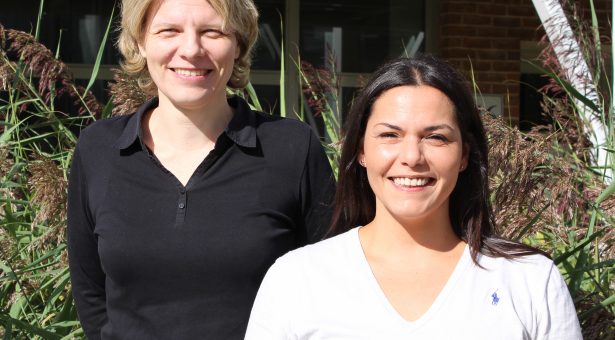John Innes Centre researchers awarded Royal Society University Research Fellowships

Two John Innes Centre researchers today reflected on a major career milestone after being awarded prestigious Royal Society University Research Fellowships.
Dr Laila Moubayidin and Dr Susan Schlimpert can now establish their own independent research groups following the awards which take effect from January 2019. The University Research Fellowship Scheme aims to provide outstanding early career scientists who have the potential to become leaders in their chosen fields with the opportunity to build an independent research career.
Dr Moubayidin’s research aims to understand how conserved mechanisms regulate symmetry establishment in plant organs.
“When I got the award, I felt like all the hard work I had put in was finally worth it. I felt like I had won the Olympic Games in plant biology,” she said.
“I am grateful to all of those that took part with me in this journey: my mentors and peers who guided me toward achieving this prestigious award,” she added.
Dr Schlimpert’s research aims to improve understanding of the molecular and cellular processes that control cell division and cellular differentiation in multicellular bacteria, such as the antibiotic producers Streptomyces.
“I am delighted to have received this fellowship. This funding will provide me with the freedom to develop my research and to establish my own independent research group at the John Innes Centre,” she said.
“I am very grateful that the Royal Society is supporting the investigation of basic research in Streptomyces and the opportunity to study how these fascinating bacteria grow and divide, “ she added.
The Royal Society has appointed 42 University Research Fellowships for 2018. In total 24 universities and academic establishments are represented. Thirteen out of the 42 appointments (31%) were made to women.
What research will the University Research Fellowships fund?
Dr Laila Moubayidin: My future research aims to understand how a defined molecular program controls symmetry foundation during the formation of a young organ in plants. In addition to being associated with beauty and harmony, symmetry is a functional necessity in biology as it provides fitness advantages. Symmetry is also needed at the single organ level, promoting function and determining developmental advantages. For example, bilateral leaves evolved to efficiently catch light, while radial roots are optimal for penetrating into the soil.
However, several important questions regarding symmetry establishment during development remain unanswered. By what molecular mechanism does a leaf become bilateral or a root radial? Does this mechanism work as a switch that can be turned on or off according to the type of symmetry an organ wants to achieve? I aim to answer these questions by studying the genetic and molecular interaction between key transcription factors, hormone dynamics and core components of the cell cycle.
How does this award advance your long term scientific aims and how this might be applied?
I aim to achieve a fundamental understanding of how cell division and hormones impose bilateral or radial symmetry establishment across all plant organs, thereby identifying new directions for improving crop performance as well as pointing out implications in human disorders where organ symmetry is impaired.
What research will the University Research Fellowships fund?
Dr Susan Schlimpert: Cell division is essential for every cell to grow and propagate and one of the fundamental questions in biology is to understand how cells determine the future site of division. In bacteria, cell division is best understood for a handful of model bacteria, but it is much less clear how filamentous growing bacteria like Streptomyces determine the future division site because these bacteria lack the classical control mechanisms that ensure proper cell division in other bacteria.
Interestingly, Streptomyces undergo two functionally distinct modes of cell division which allows these bacteria to grow as multicellular organisms and to divide into unigenomic spores. The goal of my research is to understand how Streptomyces determine when and where to divide and how this event is coordinated with other cellular processes, including growth, morphological differentiation and chromosome organisation.
How does this award advance your long term scientific aims and how this might be applied?
This research will provide novel insights into molecular mechanisms underpinning cytokinesis and multicellular development in bacteria. In addition, Streptomyces are also renowned producers of a vast majority of antibiotics and numerous other medically important compounds used to fight infectious diseases, treat cancer or to help organ transplant patients. The production of antibiotics is tightly coordinated with the growth and the timing of cell division in Streptomyces. Hence, my research has the potential to aid in the development of new experimental strategies to fully exploit the potential of Streptomyces for human benefits.



